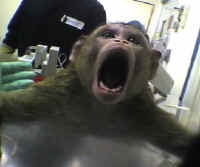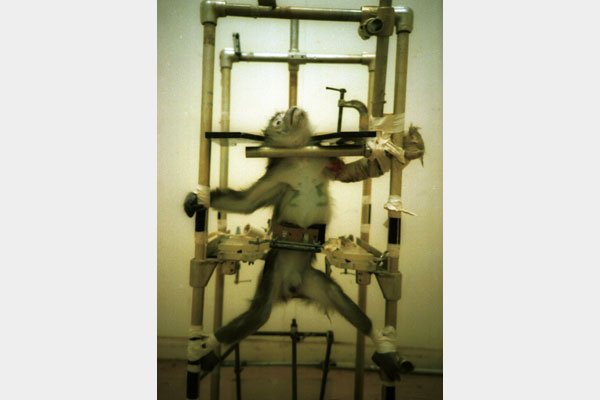
“A righteous man regards the life of his animal,
but the tender mercies of the wicked are cruel.”
(Proverbs 12:10)
Table of Contents:
Christian Attitudes
Oath of God’s Perspective – Animal Welfare
America’s Corporate Factory Farms
Widespread Animal Husbandry Corruption
America’s Research Laboratories
In Their Own Words
World’s Largest Chimpanzee Laboratory
The Greed
Republican Congressman Tom Marino & Republican Strategist Glenn Beck
Greed: Researchers Angry at Researchers
Lethal Medicine – Part 1
Researchers – Spending Your Tax Money
Rat Intelligence – How Amazing!
Milk is Cruel
Animal Models vs Human Models
We Quote an Expert – Dr. Akhtar
The Life-cycle of a Battery Cage Hen
Genetic Engineering of God’s Animal Kingdom
Pharmaceutical Research Meets Animal Husbandry
Cosmetic & Consumer Product Testing on Animals
Atheism and Darwinism in America’s Research Labs
Written by Elizabeth
Oath of God Ministries
 Christian Attitudes: Over the many years, it appears that the secular population has shown a stronger understanding of stewardship over the animal kingdom than most Christian believers. So often we hear Christians say “The animal rights activists care more about saving a dog’s life over that of an unborn baby”. Sadly many of these same Christians give very little time or money to advance the pro-life cause and much of the world remains secular because Christians aren’t evangelizing. Many Christians have little knowledge of the animal welfare movement and remain unaware of the dark corners and pockets of evil that activists continue to uncover and bring to light.
Christian Attitudes: Over the many years, it appears that the secular population has shown a stronger understanding of stewardship over the animal kingdom than most Christian believers. So often we hear Christians say “The animal rights activists care more about saving a dog’s life over that of an unborn baby”. Sadly many of these same Christians give very little time or money to advance the pro-life cause and much of the world remains secular because Christians aren’t evangelizing. Many Christians have little knowledge of the animal welfare movement and remain unaware of the dark corners and pockets of evil that activists continue to uncover and bring to light.
Therefore the Christian who doesn’t possess the facts yet continues to ridicule the animal welfare movement should be very careful not to call evil good, and good evil; or to speak darkness for light, and light for darkness. God is the Creator and whenever a Christian does not take his rightful place in stewardship, God will use others to fill the vacuum to accomplish His plans in placing restraints on widespread evil. Ironically Christians are feeding their own children various meat products such as chicken, turkey, pork and beef that are banned in up to 160 nations worldwide while mocking the animal welfare activists who are striving to improve conditions for both the farm animals and humans. It has been duly noted that many Jewish Rabbi’s across America continue to speak-up against the corrupt animal husbandry practices while advocating boycotts on specific meat products while the church has remained silent. Oath of God Ministries remains grateful for their voice. Back To Top
Oath of God’s Perspective – Animal Welfare:  For the record, Oath of God Ministries stands very strong on pro-life issues and Christ’s great commission to evangelize the world but also realizes the critical need for targeted animal welfare activism in preventing the excessive and inhumane abuses against animals found in America’s biomedical and product testing laboratories, universities, and animal husbandry factory farms. Sadly the Christian tradition does not have an impressive track record in either understanding the problems which make animal welfare necessary or what steps are critical to correcting the problems. Back To Top
For the record, Oath of God Ministries stands very strong on pro-life issues and Christ’s great commission to evangelize the world but also realizes the critical need for targeted animal welfare activism in preventing the excessive and inhumane abuses against animals found in America’s biomedical and product testing laboratories, universities, and animal husbandry factory farms. Sadly the Christian tradition does not have an impressive track record in either understanding the problems which make animal welfare necessary or what steps are critical to correcting the problems. Back To Top
America’s Corporate Factory Farms: We first point to America’s corporate factory farms for abandoning their husbandry duties towards the animals in their care prior to slaughter where some of the most oppressive conditions in the history of our nation have been imposed upon animals. The motivation is greed on the supply side. The demand for convenience and cheap prices is on the consumer side. Since corporate greed is not expected to change – the burden is on the consumer to protect his family from inferior meat, dairy and egg products much of which contains suspected drug residue. The Christian believer should always be concerned that the highest ethical standards based on God’s animal husbandry designs are applied throughout the life of every livestock animal destined for human consumption.
We further believe that even with God’s permission for Noah and his descendants to consume animals for the purpose of diet, the gross and daily abuses taking place in today’s corporate factory farms are unwarranted by mankind and have also resulted in providing an inferior and oftentimes unsafe product for human consumption.
Oath of God Ministries condemns the corrupt processes found in America’s factory farms where gestation crates, battery cages, daily beatings as well as chain dragging, crane lifting and bulldozing of downed animals into slaughter are both common and widespread practices. There is an increase in public outrage over the inhumane conditions found in today’s factory farms which has created a demand for higher quality product void of growth hormones, steroids, harmful drugs, genetically modified animal flesh, and GMO drug laced animal feed most of which the major health organizations consider unhealthy for human consumption.
If the cruel confinement of farm animals in tandem with the frequent injection of pharmaceutical drugs were not enough burden for these animals – genetic biotech engineer researchers are now perverting the original body design, cycles of reproduction, and food habits of livestock animals from what our Heavenly Creator first intended. The suffering is beyond measure for these animals. Many of the genetically altered livestock and poultry are born with birth defects and biological pathologies all of which are destined for the consumer’s dinner plate.
In our article titled, “Why God Doesn’t Always Heal” you will find the chapter section, “Chronically Trespassing God’s Physical Laws“ where you can learn more about some practical approaches to overcoming the corruption in America’s food system. There is not time or space in this particular segment to outline these required practices. Please click on Chronically Trespassing God’s Physical Laws and quickly return to this segment to finish the reading.
A person does not sin if he eats a meat diet nor does he sin if he eats a vegetarian diet but the inhumane practices found in America’s factory farms and the inferior products resulting from these same practices can no longer be ignored by Christians.
In fact, the abuses in the corporate factory farms are so great that we are speechless in describing them. Separate pages have been reserved to describe in greater detail the inhumane conditions in today’s factory farms. Back To Top
Widespread Animal Husbandry Corruption
America’s Research Laboratories: Oath of God Ministries does acknowledge that there are some medical researchers who are both fiscally responsible and humane in their research procedures. In response, however, to the (NIH) National Institute of Health’s recent comments on wasting billions of taxpayer dollars on animal research over the past several decades without yielding viable scientific results, we believe that many researchers as well as the NIH have been irresponsible in their stewardship over both our tax dollars and the animals left in their care. This in itself points to a very serious, deep rooted and widespread problem motivated by greed. Back To Top
1. At a meeting on June 4, 2013, which focused on federal funding for science, the former (NIH) National Institutes of Health director Elias Zerhouni admitted that experimenting on animals has basically failed and proven too expensive. “We have moved away from studying human disease in humans,” he lamented. “We all drank the Kool-Aid on that one, me included. With the ability to knock in or knock out any gene in a mouse—which “can’t sue us,” Zerhouni quipped—researchers have over-relied on animal data. “The problem is that it hasn’t worked, and it’s time we stopped dancing around the problem…We need to refocus and adapt new methodologies for use in humans to understand disease biology in humans.” (1)
2. “We want to migrate away from animal testing. We also want to see drug development become more efficient so that fewer resources are wasted”(2) per David Jacobson-Kram, former (FDA) Food & Drug Administration, Executive Director for pharmacology and toxicology.
3. Elias Zerhouni is not alone in his sentiments regarding the failure of animal research. Drugs tested successfully on animals are ineffective and oftentimes dangerous for humans. According to Health and Human Services Secretary Mike Leavitt, “Currently, nine out of ten experimental drugs fail in clinical studies because we cannot accurately predict how they will behave in people based on laboratory and animal studies,” (3)
4. Dr. Frank Collins, current NIH Director writes, “More than 30% of all drugs successfully tested in animals later prove toxic in human trials. The NIH plans to commit $70 million over the next five years to develop “tissue chips”—miniature 3-D organs made with living human cells—to help predict drug safety and efficacy. Though this is high-risk research, these chips may ultimately provide better models of human disease and biology than the use of animals.”(4) The concern which Oath of God Ministries has with any tissue model using human cells is whether or not these human cells are embryonic stem cells or adult stem cells. We condemn the use of embryonic stem cell research in any experiment as we view the destruction of embryos as the destruction of human life.
5. As early as 1998, Dr. Richard Klausner, former Director of the National Cancer Institute, stated, “The history of cancer research has been a history of curing cancer in the mouse. We have cured mice of cancer for decades, and it simply didn’t work in humans.”(5) Decades later we are still using mice and other animals. Billions of dollars of taxpayer dollars have been poured into these experiments as well. Since mice, rats and birds do not come under the AWA protections many experiments have been cruel, painful as well as abusive and have yielded few scientific results.
6a. “Earlier this year, a high-profile study found that sophisticated tests using human cells accurately predict what happens to people when they’re burned and suffer infections, but that the standard method of burning mice’s skin off in experiments does not. Scientists now understand why all 150 drugs developed using these animals didn’t work in human patients.” (6) Again, we are not being told as to whether or not these human cells are embryonic or adult stem cells.
6b. Dr. Collins, like so many other researchers thought “If it works in mice, so we thought, it should work in humans. But when it comes to molecules designed to target a sepsis-like condition, 150 drugs that successfully treated this condition in mice later failed in human clinical trials—a heartbreaking loss of decades of research and billions of dollars. (7) A new NIH-funded study reveals why.
7. “A landmark 2011 study by the Institute of Medicine found that “most current biomedical research use of chimpanzees is unnecessary.” A subsequent NIH report agreed and even concluded that “research involving chimpanzees has rarely accelerated new discoveries or the advancement of human health for infectious diseases.”(8) Only the United States and Gabon use chimpanzees as an endangered species in animal laboratory experiments.
The NIH has determined that experiments on chimpanzees hasn’t accelerated anything new. So what type of experiments were performed on these socially-oriented creatures up until now? “NIH was spending millions on things like strapping down chimpanzees to have thousands of mosquitoes feed on their bare skin and separating baby chimpanzees from their mothers, locking them alone in cages, and forcing liquid, filtered from human stool, down their throats to intentionally sicken them with stomach viruses.”(9)
Some Chimpanzees have lived in small 5’ x 5’ x 7” cages most of their lives despite their social nature and need to travel. “This is an historic moment and major turning point for chimpanzees in laboratories—some who have been languishing in concrete housing for over 50 years,” said Wayne Pacelle, President and CEO of The Humane Society of the United States.(10)
Can you imagine living in a closet for 50 years?
8. “Indeed, because oncology drugs have a success rate of only 5%, it is clear that animal models are only marginally effective.”(11)
9. “Mouse models that use transplants of human cancer have not had a great track record of predicting human responses to treatment in the clinic. It’s been estimated that cancer drugs that enter clinical testing have a 95 percent rate of failing to make it to market, in comparison to the 89 percent failure rate for all therapies.”(12) According to Cheryl Marks, Phd and Division Associate Director with the National Cancer Institute’s Division of Cancer Biology stated, “Indeed, “we had loads of models that were not predictive, that were [in fact] seriously misleading,”(13)
10. Although pharmaceutical companies currently and frequently use dogs in toxicity tests for pharmaceutical compounds (overdosing & killing them), as early as 1993 it was realized, “Why the dog was ever considered as an appropriate animal for carcinogenicity testing is also not entirely clear… Despite the obvious problems of study design and interpretation, carcinogenicity tests in the dog, lasting 7 years, were requested by regulatory authorities from the late 1960s…One of the best known examples of the inappropriate use of the dog was the carcinogenicity testing of hormonal contraceptives. It is now understood that mammogenesis in the dog is very different from that in primates; quantitative and qualitative differences exist in the feedback control mechanisms, receptor content and behavior, and target sensitivity and responsivity. As a result of this biological difference there was a high incidence of mammary tumours in long-term studies in dogs treated with progestagens/contraceptive steroids such as lynestrol. Ultimately pressure from the scientific community led, relatively recently, to the requirement for carcinogenicity studies in dogs being dropped.” (14)
Zerhouni’s statement clearly defines why the activists have been protesting animal research methods for decades and we can only assume how many other people in our culture drank the Kool-Aid along with Elias Zerhouni.  The main reason that animal research has not satisfied the NIH’s expectations is that for decades the researcher believed that the biochemical mechanisms or physiological responses in an animal would be the same for man.
The main reason that animal research has not satisfied the NIH’s expectations is that for decades the researcher believed that the biochemical mechanisms or physiological responses in an animal would be the same for man.
Despite the billions of dollars invested it has resulted in a plethora of unsafe drugs and a waste of both taxpayer money and animal life. The activists have been exposing these problems for decades. Animal research is big business. The steady stream of tax payer money continues to be pumped into the laboratories whether or not an effective drug is found, a cure is discovered, or the researcher cares to comprehend the suffering of any animal. Indeed biomedical and pharmaceutical research is very big business. Back To Top
World’s Largest Chimpanzee Laboratory
(Endangered Species in America’s Research Laboratories)
Avarice and systematic methods steeped in research tradition are also contributing factors to NIH’s irresponsibility. The NIH receives a continual glut of proposals for research grants from both universities and other research labs. It spends an estimated 14.5 billion dollars on animal research which is almost 50% of its entire annual budget of $30.2 billion. (15) In these myriad experiments, monkeys, chimpanzees, dogs, cats, mice, rats, hamsters, rabbits and other animal models are used with the majority of them dying very painful deaths.
According to the NIH “More than 80% of the NIH’s funding is awarded through almost 50,000 competitive grants to more than 300,000 researchers at more than 2,500 universities, medical schools, and other research institutions in every state and around the world. About 10% of the NIH’s budget supports projects conducted by nearly 6,000 scientists in its own laboratories, most of which are on the NIH campus in Bethesda, Maryland. (16)
Grant money helps to pay for the high paid salaries of tenured professors and the various department overheads in universities across America. “Between 45 to 50% of every research grant won by the faculty member is labeled “indirect costs” and retained by the university. This can be an astounding amount of money (at least $112,500 on a typical $250,000 a year NSF grant) and goes to the university to pay for general expenses like electricity and providing an office staff. This is a high rate, and as such, the “indirect costs” also re-pay a part of the researcher’s start-up package. In a faculty member’s career, however, one can see how they could pay for their start-up costs several times over if they maintain a number of grants over their lifetime, allowing the university to profit in addition to any work done by the professor in the classroom or committees.“(17) Back To Top
Republican Congressman Tom Marino & Republican Strategist Glenn Beck
click on gold link
Yes! – They Really Get It!
Even Elias Zerhouni, former (NIH) National Institutes of Health director admitted, “Even I shared, for example, in Congress that the $4 per year invested per person in the United States since the 1970s on cardiovascular research now results in $2.5 trillion of economic value every year. The problem with these kinds of statements is that you can easily make them, but you can’t easily prove them.” (18) Dogs are frequently used in cardiovascular research where many of the experiments are highly repetitive and archaic. In the same speech, Zerhouni admitted that animal research hasn’t worked out and where billions have been lost yet he vaunts how research has boosted the economy. The economic value experienced by Wall Street which directly benefits the pharmaceutical and biotech corporations, whether cures are found or not found, may not trickle down to the average tax payer who wants research to save lives not boost the economy through artificial stimulus programs.
If the NIH were to stop this enormous money eating machine – job losses would ripple through the NIH as well as university staffs and research laboratories across America. A reasonable portion of our tax dollars, however, would no longer be squandered on wasteful and cruel experiments.
Greed: Researchers Angry at Researchers
click above
Despite the fact that NIH has admitted to losing billions of dollars over several decades using animal research, it has also admitted that every $1 of NIH funding generates $2.20 in economic growth.(19) It appears that the NIH has created an artificial stimulus program which has pumped billions of dollars into worthless and highly repetitive animal experiments over several decades which has allowed the universities and biomedical field as a whole to financially flourish. These experiments, however, have caused undue physical pain and mental suffering upon hundreds of millions of animals over the many decades. Can anyone blame the activists for protesting.
If God didn’t approve a study which used an animal as its model and the animal experienced great suffering and pain, it was nothing more than an artificial stimulus program void of any scientific merit which used taxpayer dollars and wasted an animal’s life or prolonged the animal’s undue suffering and misery. In this situation a satanic edge followed the timeline throughout the entire experiment.
A typical study using animal models has no established deadline for a cure. This can result in a meandering trail of research where very repetitive and highly unwarranted animal experiments take place but with little oversight from NIH authorities.
 Under sequestration, the NIH will see its budget cut 5.1 to 7.3 percent in 2013 and remain stagnant through 2021. The sequestration requires NIH to cut 5 percent or $1.55 billion of its fiscal year (FY) 2013 budget. NIH must apply the cut evenly across all programs, projects, and activities (PPAs), which are primarily NIH institutes and centers. This means every area of medical research will be affected. In the next three years, this reduction in R&D is projected to decrease the number of jobs by 600,000.(20) For every six applications submitted to the NIH, only one will be funded. (21) Therefore the NIH will need to exercise greater discretion when allocating its grant and research monies to researchers.
Under sequestration, the NIH will see its budget cut 5.1 to 7.3 percent in 2013 and remain stagnant through 2021. The sequestration requires NIH to cut 5 percent or $1.55 billion of its fiscal year (FY) 2013 budget. NIH must apply the cut evenly across all programs, projects, and activities (PPAs), which are primarily NIH institutes and centers. This means every area of medical research will be affected. In the next three years, this reduction in R&D is projected to decrease the number of jobs by 600,000.(20) For every six applications submitted to the NIH, only one will be funded. (21) Therefore the NIH will need to exercise greater discretion when allocating its grant and research monies to researchers.
Despite these budget cuts, the NIH is committed to spending $70 million over the next five years to develop “tissue chips” as an alternative to animal research. The chips are miniature 3-D organs made with living human cells which will help to predict drug safety and efficacy.(22) Research hopes to prove that the chips will provide better models of human disease and biology than animals. This new direction is long overdue as many animals have been and continue to be used and oppressed in ways which were not intended by our Creator. Back To Top
Lethal Medicine – Part 1
Research on Animals
:
Back To Top
Researchers – Spending Your Tax Money:
According to Dr. Richard Klausner, director of the National Cancer Institute, “The history of cancer research has been a history of curing cancer in the mouse. We have cured mice of cancer for decades, and it simply didn’t work in humans.” (23) It is reasonable to believe that if mice are not perfect models to cure disease in humans, then humans cannot be perfect models to cure disease in mice. We can say the same for the chimpanzees, dogs, cats, goats, sheep, non-human primates, who have been used in cruel experiments for many decades.
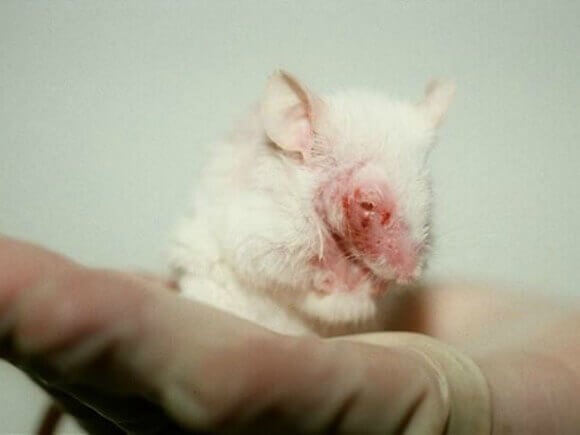 His entire paw was burned off. His face, eyes and necked were severely burned.
His entire paw was burned off. His face, eyes and necked were severely burned.
There is no AWA protection for this animal model. No anesthesia.
Pigs and Dogs have been burned in experiments as well.
Although mice and humans are completely different from one another, researchers continue to use them for experimentation not because there’s scientific evidence showing the need for this model but because mice are small, cheap and disposable. The mouse brings in a great deal of grant money issued by the NIH to the researcher. The more experiments that can be financed through NIH”s funding the more secure the staffing jobs remain. Along with birds, rats, and amphibians, the mouse doesn’t come under the protection of the AWA Animal Welfare Act. Anything can be done to them using our taxpayer dollars. They can starve them to death, burn their skin off, inflict enormous pain without raising red flags, drown them in experiments, severe finger digits to identify them, smash them against walls and gas them. Because it is easy and there’s no accountability.
This is only tiny sampling of a wide spread problem. This is brief snapshot of how your taxpayer money is wasted and how the animals also experience enormous pain and suffering.
– Boston University drilled holes into female mice’s skulls, burned lesions into their brains, and recorded the amount of time the mice spent sniffing male rats’ urine samples. The models were subsequently killed.(24) Taxpayer cost was $1,505,173
– University of California-Berkeley cut holes into female hamsters’ skulls, pumped hormones into their brains, sexually stimulated them with brushes, and measured their sexual receptivity. (25) Taxpayer cost was $1,817,502
– Johns Hopkins University cut the skin off live mice and rats’ penises and pierced the right corpus cavernosum with a 30-guage needle attached to a PE-50 tubing connected to a pressure transducer. The organs were electrically stimulated for five minutes, and the animals were injected with chemicals to see if they could sustain an erection. (26) Taxpayer cost was $2,792,144
– Texas Women’s University injected female rats with antidepressants because 30-50% of all human women on antidepressants experience some form of sexual dysfunction. The female rats were subsequently placed with male rats. Their interaction was observed and measured. Their ovaries were removed. They were injected with sex hormones and their behavior was observed again.(27) Taxpayer cost was $2,024,949
– University of Michigan & University of Western Ontario cut open rats’ skulls, implanted tubes in their brains. Experimenters administered chemicals to block sexual pleasure. The male and female rats were observed together and sexual activity was measured. The experimenters killed the rats and dissected their brains for further study. (28) Taxpayer cost was $4,547,605
– Effects on Rat Sexual Behavior of acute MDMA (ecstasy) Alone or in Combination with Loud Music was filed with the National Center for Biotechnology Information (NCBI) which is part of the US National Library of Medicine (NLM), a branch of the (NIH) National Institutes of Health by Italian researchers. The value of its conclusion indicates a worldwide pattern of questionable experiments
Its summary indicated that environmental conditions, e.g. acoustic stimulation typical of the “rave scene” can influence the toxicity of the ecstasy.
In other words, to increase the heightened effectiveness of ecstasy, an illegal drug that produces both stimulant and psychadelic effects in a human, a person simply needs to turn up the loud music.

Killing the Mouse after Experimentation can be accomplished using various methods. Should a mouse or rat survive the experiment it is almost always killed. There is nothing preventing a technician from crushing its head or throwing it against the wall to kill it. Some institutions try to follow proper protocol to euthanize using any of the following techniques: cervical dislocation, decapitation, ex-sanguination is used to ensure death subsequent to electrical stunning, microwave Irradiation, or carbon monoxide. Decapitation of post-natal rodents (>14 days of age) without prior narcotization or anesthesia is conditionally acceptable. This names the most frequently used euthanasia methods. (29) Back To Top
Rat Intelligence – How Amazing!
Click the above link
Back To Top
Milk is Cruel
Widespread Across America
Decades ago, Christopher Anderegg, MD, Phd who obtained his MD from Yale University School of Medicine and his PhD in Biology from Yale Graduate School and former animal experimenter stated “There are many reasons why animal experimentation is an unscientific, invalid, dangerous, counterproductive, but above all fraudulent method. The main reason for me as a doctor and biologist is a very simple one, not just based on science or medicine but based on pure and simple common sense and logic. Animals are physiologically, anatomically, biochemically histologically among so many countless other reasons totally incomparable to human beings.” (30)
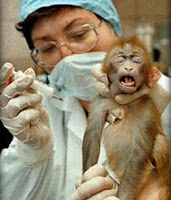
Dr. Albert Puerini, a Cranston, Rhode Island physician and a representative of (PCRM) Physicians for Responsible Medicine would also agree with Dr. Anderegg’s viewpoint regarding medical research. Dr. Puerini fought Rhode Island Hospital’s researchers when they used baby piglets to study the affects of alcohol in humans with cardiovascular risk. The researchers claimed that forcing young piglets to consume alcohol would “shed new light on the mechanisms by which moderate alcohol intake might reduce cardiovascular risk,” Dr. Puerini, however, called the experiments “completely unnecessary” because pigs’ responses to alcohol “can’t be extrapolated to humans.” The federal money that financed the research would be better spent on combating alcohol abuse, a serious problem in Rhode Island,” (31)
To support Dr. Anderegg’s view, we point to biblical scripture. In the beginning God made “each according to its own kind”. God’s eternal Word never changed – just human opinion about it. For example, when a researcher burns a beagle puppy with kerosene to induce 3rd degree burns – we must remember that the human skin heals differently than a dog’s skin because humans don’t have fur. When injecting ad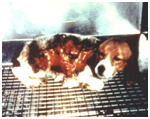 dictive heroine into a chimpanzee, we must remember that when humans are delivered of substance abuse the spiritual component, which a chimpanzee does not possess, must be taken into consideration. When a researcher electrocutes a dog to induce depression – we must remember that depression in humans has many different components most of which have nothing to do with electrocution. When experimenting with hormones in a mouse – we must remember that the hormones in an adult woman function in an entirely different way than a mouse’s hormones.
dictive heroine into a chimpanzee, we must remember that when humans are delivered of substance abuse the spiritual component, which a chimpanzee does not possess, must be taken into consideration. When a researcher electrocutes a dog to induce depression – we must remember that depression in humans has many different components most of which have nothing to do with electrocution. When experimenting with hormones in a mouse – we must remember that the hormones in an adult woman function in an entirely different way than a mouse’s hormones.
Even Francis Collins, NIH Director admitted “Mice, however, apparently use distinct sets of genes to tackle trauma, burns, and bacterial toxins—when the authors compared the activity of the human sepsis-trauma-burn genes with that of the equivalent mouse genes, there was very little overlap. No wonder drugs designed for the mice failed in humans: they were, in fact, treating different conditions! (32) Nevertheless these cruel and inhumane experiments bring large pools of money to the researchers despite the unscientific merit.” Back To Top
We Quote an Expert – Dr. Akhtar
Aysha Akhtar, MD, MPH, is a double Board-certified neurologist and public health specialist. She works for the Office of Counter-terrorism and Emerging Threats of the Food and Drug Administration (FDA), serves as Lieutenant Commander in the US Public Health Service, and is a Fellow of the Oxford Centre for Animal Ethics. She also serves on the Leadership Council of the Classy Awards.
“Bottom line: any experiment, no matter how painful or how much suffering it causes, can be justified under the guise of “science.” We want to believe that those in the white coats are acting responsibly and that the animals are treated humanely. Well, I have visited numerous laboratories and witnessed countless experiments on animals and I can tell you from personal experience that nothing is further from the truth. As soon as you walk into a laboratory, you can’t help but notice the rows and rows of barren cages holding sad animals living under the glare of fluorescent bulbs. Their bodies are burned, mutilated and scarred. Animals who have had their heads crushed grip their faces and convulse as blood pours out of their noses. You can smell and taste the stench of blood, feces and fear.”(33) Back To Top
The Life-cycle of a Battery Cage Hen
(Turn off audio if you don’t like the music)

Restraints are used daily on non-human primates sometimes all day long
Genetic Engineering of God’s Animal Kingdom

This is a complicated topic which appears to be offering more controversy than anything else. Scientists on a global basis have been genetically engineering farm animals with the hope of producing livestock that are much larger and resistant to disease. Although this sounds pleasant on paper it is nothing but abject misery for the animal. Although there has been a never ending surge of consumer protests against anything that is genetically modified for food consumption, governments on a global scale as well as their genetic researchers continue to both widen and accelerate their pace in this area.
If the cruel and long-term confinement of farm animals as well as the frequent injection of harmful drugs, many which have been banned by other nations, were not enough burden for the animals – researchers are now genetically altering their bodies to the point where they no longer represent what God called good in Genesis “And God made the beast of the earth according to its kind, cattle according to its kind, and everything that creeps on the earth according to its kind. And God saw that it was good.” (Genesis 1:25) Let’s remember that God made each according to its kind. God didn’t mix the DNA of a human with the DNA of an animal which is described in more detail but later in this article. The commercial factory farmed animals whose bodies are genetically modified to produce more litters and to grow faster have a design that is now too burdensome for them to manage. It is human selfishness. It is cruel. It is driven by greed. These are not God’s methods and there is no further excuse to support what is so obviously evil.
“A world in which chickens with such explosive growth they have to be starved lest they risk cardiac rupture. “Double-muscled” calves born into the beef industry so freakishly huge that they can only be extracted via Caesarian section. A hen laying so many eggs that she risks a prolapse–laying her own uterus. A cow capable of generating ten times more milk than a calf could ever suckle. Imagine a world in which turkeys are so top-heavy they are physically incapable of mating.” (34)
Animal welfare advocates and the general public are already protesting the genetically engineered poultry (broilers) that are manipulated to grow abnormally fast. An inordinately high number of poultry are born with birth defects and aberrant pathologies. The birds cannot support their own weight and the rapid growth has resulted in frequent heart failures for many chickens. These genetically altered birds are unable to cope with such robust growth and must oftentimes be starved in order to save them. Videos show birds experiencing heart attacks where their red bulbous hearts protrude and pound outside their chests prior to death. Today’s factory farms provide a setting of filth and darkness to these pitiful broilers where the survivors eventually make it to your dinner plate.
According to Karen Davis, Phd, United Poultry Concerns in her article titled, “Genetic Engineering and Cloning of Domestic Fowl” she states that Lesley J. Rogers, avian specialist, aims at “blunting” the minds of the animals so that they are no longer aware of the misery that mankind has imposed on them in today’s factory farm environments. Blunting their minds actually translates to removing their minds altogether. Davis quotes Lesley Rogers as saying, “so blunted that they will passively accept overcrowded housing conditions and having virtually nothing to do but eat—and then to eat standard and boring food delivered automatically” (p. 185).
Oath of God Ministries condemns this research practice as being potentially harmful to humans and grossly inhumane to God’s creation. Separately, British researcher Helen Sang has developed chickens infused with human DNA that contains proteins that can fight skin cancer. Its usefulness, however, has never proven successful. Richard Gray, Science Correspondent for The Telegraph wrote a 4/2/2011 article titled, “Genetically Modified Cows Produce ‘Human’ Milk” stating “China is now leading the way in research on genetically modified food and the rules on the technology are more relaxed than those in place in Europe. The scientists have successfully introduced human genes into 300 dairy cows to produce milk with the same properties as human breast milk. Scientists insist genetically modified foods are unlikely to pose a threat to food safety and in the United States consumers have been eating genetically modified foods for many decades. However, during two experiments by the Chinese researchers, which resulted in 42 transgenic calves being born, just 26 of the animals survived after ten died shortly after birth, most with gastrointestinal disease, and a further six died within six months of birth.
Richard Gray further writes, “Researchers accept that the cloning technology used in genetic modification can affect the development and survival of cloned animals, although the reason why is not well understood.”(35) Oath of God Ministries believes that answer rests with God Almighty since He alone is the Creator and researchers are tampering with both animal and human DNA which resides in the blood. God makes it perfectly clear to the entire universe that “life is in the blood” for both man and animal and He created each one according to its own kind. In a separate issue in Great Britain, “Figures seen by the Daily Mail show that 155 ‘admixed’ embryos, containing both human and animal genetic material, have been created since the introduction of the 2008 Human Fertilization Embryology Act. This legalized the creation of a variety of hybrids, including an animal egg fertilized by a human sperm; ‘cybrids’, in which a human nucleus is implanted into an animal cell; and ‘chimeras’, in which human cells are mixed with animal embryos” according to Mail Online, dated July 22, 2011 titled “150 human animal hybrids grown in UK labs: Embryos have been produced secretively for the past three years”.
Josephine Quintavalle, of pro-life group Comment on Reproductive Ethics, believes “The problem with many scientists is that they want to do things because they want to experiment. That is not a good enough rationale.”(36) Lord Alton who argued in Parliament against the creation of human- animal hybrids stated, “None of the scientists who appeared before us could give us any justification in terms of treatment.”(37) Some researchers do agree that stricter controls will be needed in the future where animal embryos are implanted with a small amount of human genetic material.
Consumers across the globe are protesting against anything that is genetically modified. According to a June 2013 ABC News poll – 93 percent of Americans support mandatory labels on foods containing GMOs, 57% are less likely to buy GM foods and 62% believe GMO foods are unsafe.((38) It is a sore spot for consumers and it is changing grocery shelves across the world. The average consumer no longer wants to consume GMO produce or GM animals.
There has been an ongoing debate over the validity of a study done by French scientists which showed that GMO foods (genetically modified Organisms) do cause cancer in research animals. The researchers used 200 albino Sprague-Dawley rats – 100 hundred females and 100 males as their animal model. Michelle Castillo, CBS News Correspondent writes in her 9/21/2012 article titled Study Says Genetically Modified Corn Causes Tumors, but Other Scientists Skeptical About Research writes “The results showed that female rats were two to three times more likely to die than the control group. Fifty percent of the males and 70 percent of the females eating Monsanto GM maize died earlier compared to 30 percent of males and 20 percent of females not eating genetically modified products. Female rats seemed to be more negatively affected by genetically modified corn diets whether it was sprayed with Roundup or not.” The photographs of tumor riddled rats have had an impact on consumers worldwide.
The debate continues and additional studies are taking place to confirm the data. We do know that Americans have been eating genetically modified crops for decades now, that no cure for cancer exists and that many Americans continue to die of cancer but whether or not this is caused by GMO foods is yet to be determined. When in doubt, buy organic produce, and 100% grass fed or pasture-raised animal and poultry meat with the label “Animal Welfare Approved”.
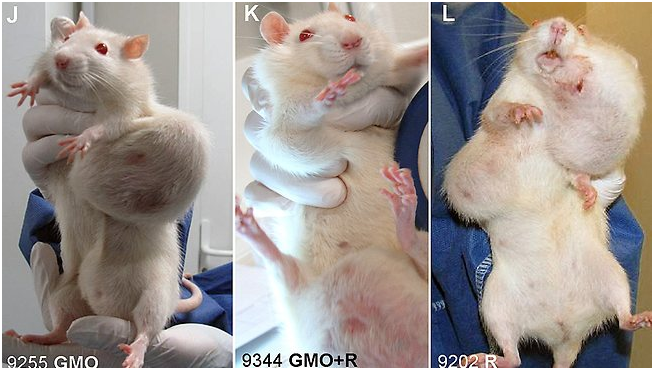
In 2007 South Korean scientists genetically altered a cat’s DNA which caused it to glow in the dark. Other cats were cloned from it. This effort was duplicated by US scientists in 2008 to help find cures for diseases like cystic fibrosis although it has not resulted in any current breakthrough.
“Separately, human babies have already been genetically modified by researchers. “The disclosure that 30 healthy babies were born after a series of experiments in the United States provoked another furious debate about ethics. So far, two of the babies have been tested and have been found to contain genes from three ‘parents’. Fifteen of the children were born in the past three years as a result of one experimental program at the Institute for Reproductive Medicine and Science of St Barnabas in New Jersey. The babies were born to women who had problems conceiving. Extra genes from a female donor were inserted into their eggs before they were fertilized in an attempt to enable them to conceive. Genetic fingerprint tests on two one-year-old children confirm that they have inherited DNA from three adults –two women and one man.”(39) ABC News also reported on the 30 cases
Unlike genetically modified crops or livestock, this study simply took mitochondria from two female sources but the genes were never altered although some of these children now show genes from two females and one male. In the future it is quite possible that researchers will be altering human genes prior to fertilization with the objective of creating human models who are resistant to disease. According to scientists the newborns may not look like their parents but they’ll be healthier and have the opportunity to live longer.
In 2015 the UK became the first country to approve laws to allow the creation of babies from three people.
Clearly genetics is the research frontier which genetic scientists believe will eliminate disease, provide robust crops, breed enormous livestock, and create human DNA that is resistant to disease. To some extent genetics is taking on a new Darwinian twist which aims at creating a perfect race of humans and according to the scientist speeds up the evolutionary process. Back To Top
Additional Sections on Animal Welfare
Simply “click” below to read more topics.
Pharmaceutical Research Meets Animal Husbandry
Cosmetic & Consumer Product Testing on Animals
Atheism and Darwinism in America’s Research Labs

Footnotes:
1.Ex-Director Zerhouni Surveys Value of NIH Research, NIH Record, By Rich McManus, June 21, 2013, Vol. LXV, No. 13
2. Pfizer May Gain as U.S. Devises Alternative to Animal Testing, Bloomberg Business, Anna Edney, August 5, 2010,
3. FDA Issues Advice to Make Earliest Stages Of Clinical Drug Development More Efficient, FDA News Release, P06-05, January 12, 2006
4. Of Mice, Men, and Medicine,Cancer Drugs Face Long Road From Mice to Men, Los Angeles Times, May 6, 1998, Arlene Cimons, Josh Getlin, & Thomas H. Maugh II, Times Staff
6. As Chimp Research is Phased Out, Will Other Animal Research Decline?, The Hastings Center Report, Bioethics Forum, Justin Goodman, 07/09/2013
7. Of Mice, Men, and Medicine,
8. As Chimp Research is Phased Out, Will Other Animal Research Decline?, The Hastings Center Report, Bioethics Forum, Justin Goodman, 07/09/2013
9. As Chimp Research is Phased Out, Will Other Animal Research Decline?, The Hastings Center Report, Bioethics Forum, Justin Goodman, 07/09/2013
10. National Institutes of Health to Retire Hundreds of Chimpanzees to Sanctuary, HSUS Applauds Agency’s Monumental Decision, 06/26/2013, HSUS website
11. Human and Experimental Toxicology, Vol 12, p 99-109, Parkinson and Grasso
12. The Scientist, Building a Better Mouse, Edyta Zielinska, April 1, 2010
13. The Scientist, Building a Better Mouse, Edyta Zielinska, April 1, 2010, quoting “Cheryl Marks Ph.D.
14. Human and Experimental Toxicology, Parkinson and Grasso, Vol. 12, p 99-109.
15. Feds Spend Up to $14.5 Billion Annually on Animal Testing, Daily Caller, Michael Bastasch, 10/05/2013
16. National Institute Health, NIH Budget, Research for the People, website
17. i09, Here’s What It Actually Costs to Run a University Science Lab, Keith Veronese, 08/10/2011
18. Ex-Director Zerhouni Surveys Value of NIH Research, NIH Record, By Rich McManus, June 21, 2013, Vol. LXV, No. 13
19. Sequestration Will Take Big Bite from Medical Research Funding, Los Angeles Times, Alana Semuels and Adolfo Flores, Los Angeles Times, March 21, 2013
20. Fact sheet: Impact of Sequestration on the National Institutes of Health, Sequestration, National Institute of Health, News & Events, June 13, 2013
21. Fact sheet: Impact of Sequestration on the National Institutes of Health, Risk to Scientific Workforce, National Institute of Health, News & Events, June 13, 2013
22. NIH Funds Development of Tissue Chips to Help Predict Drug Safety, NIH, News & Events, DARPA and FDA to Collaborate on Groundbreaking Therapeutic Development Initiative, June 24, 2012, NIH website
23. Cancer Drugs Face Long Road From Mice to Men, Los Angeles Times, May 6, 199, Arlene Cimons, Josh Getlin, & Thomas H. Maugh II, Times Staff
24. Forthcoming
25. Gonadotropin-Inhibitory Hormone Reduces Sexual Motivation, But Not Lordosis Behavior In Female Syrian Hamsters (Mesocricetus auratus), David J. Piekarski, Sheng Zhao, Kimberly J. Jennings, Takeshi Iwasa, Sandra J. Legan, Jens D. Mikkelsen, Kazuyoshi Tsutsui, Lance J. Kriegsfeld, Neurobiology Laboratory Department of Psychology and Helen Wills Neuroscience Institute, University of California, Berkeley, CA, PII: S0018-506X(13)00128-1, DOI: 10.1016/j.yhbeh.2013.06.006, Reference: YHBEH 3585
26. Cyclic AMP-dependent phosphorylation of neuronal nitric oxide synthase mediates penile erection, Joseph Hurt, Sena F. Sezen, Gwen F. Lagoda, Biljana Musicki, Gerald A. Rameau, Solomon H. Snyder and Arthur L. Burnett, May 2, 2012
27. Sprague-Dawley and Fischer Female Rats Differ in Acute Effects of Fluoxetine on Sexual Behavior, Chandra Suma J. Miryala, MS, Cindy Hiegel, MA, and Lynda Uphouse, PhD Department of Biology, Texas Woman’s University, Denton, TX, USA, DOI: 10.1111/j.1743-6109.2012.02981.x
28. Natural and Drug Rewards Act on Common Neural Plasticity Mechanisms with FosB as a Key Mediator, The Journal of Neuroscience, February 20, 2013 • 33(8):3434 –3442 Kyle K. Pitchers, Vincent Vialou, Eric J. Nestler, Steven R. Laviolette, Michael N. Lehman, and Lique M. Coolen
29. Forthcoming
30. Lethal Medicine – Part 1 video: quoting Christopher Anderegg, MD, Phd
31. Animal Group Files Complaint Over Experiments on Pigs by Brown, R.I. Hospital, Dec 12, 2013, Felice J. Freyer
32. Of Mice, Men, and Medicine,
Back To Top
The End
tudy
